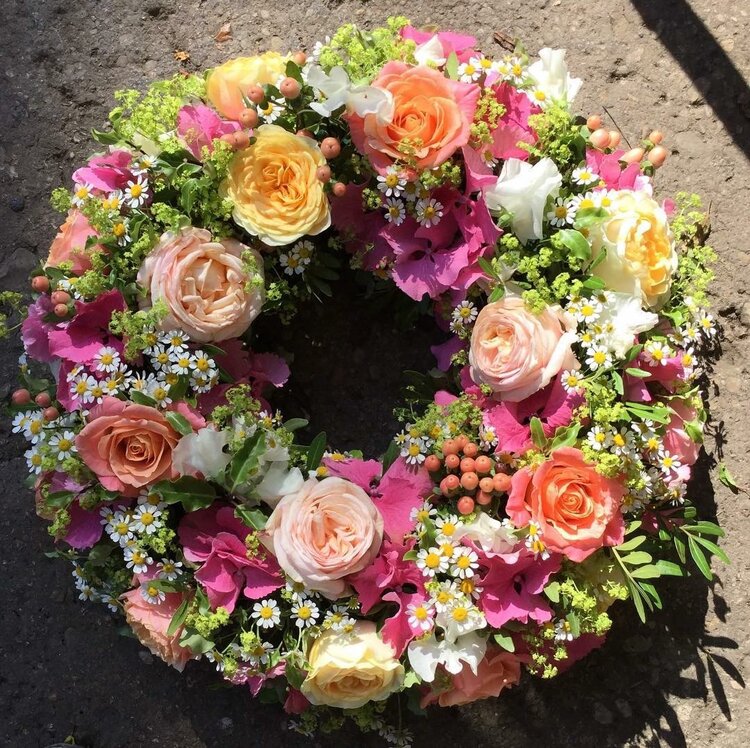FUNERAL FLOWER ETIQUETTE
Here are some tips to help simplify sending funeral flowers, including where you should send funeral flowers, whether you should attach a sympathy note, and when you should send funeral flowers.

If you’ve never sent or received funeral flowers before, it can be hard to understand the dos-and-don’ts.
Luckily, one rule of funeral flower etiquette applies to most situations, and it can help make the process a lot easier.
That rule is: it’s usually appropriate to reach out to the family and ask whether flowers are acceptable and where they’d like you to send them. Often, the family will include this information in the obituary or the funeral invitations.
Here are some tips to help simplify the situation even further, including where you should send funeral flowers, whether you should attach a sympathy note, and when you should send funeral flowers.
DO YOU HAVE TO SEND A NOTE WITH FUNERAL FLOWERS?
You don’t necessarily have to attach a lengthy note with your funeral flowers, but attaching a short note is a nice touch.
DO YOU SEND FLOWERS IF YOU PLAN ON ATTENDING THE FUNERAL SERVICE?
You can send funeral flowers whether you’re planning to attend the funeral service or not. If you’re unable to attend the funeral, sending flowers to the service can show the family you’re thinking about them. And if you’re attending the funeral, sending flowers is just an added show of support.
WHO SHOULD SEND FLOWERS TO A FUNERAL?
If you want to send flowers to a funeral, and the family is accepting flowers, you should feel free to send a floral arrangement. You might send one on your own or get together with a group of friends or colleagues to send a larger, more elaborate arrangement.
Typically, you should stick to arrangements that the family can take home, and which aren’t overly large and unwieldy.
This usually includes arrangements like bouquets, floral baskets, and wreaths, and omits standing sprays and casket sprays. The family members organizing the funeral usually order these larger arrangements themselves.
FUNERAL FLOWER ETIQUETTE MAY DEPEND ON YOUR RELATIONSHIP TO THE DECEASED
IF YOU’RE IMMEDIATE FAMILY
As an immediate family member, you have the benefit of communicating directly with the people planning the funeral. But knowing how to send funeral flowers, or whether you should at all, can be even more complicated.
As immediate family, you might be involved in setting up the funeral yourself. If you are, you can help order larger arrangements like standing sprays and casket sprays.
You could also be an immediate family member who’s not involved in planning or setting up the funeral. In that case, you still might want to send a funeral arrangement. You can send a small, medium, or large floral arrangement, or you can hand-deliver an arrangement to the funeral.
IF YOU’RE EXTENDED FAMILY
As an extended family member, you can send a floral arrangement to the family home, if you wish. Alternatively, you can have your funeral flower arrangement delivered to the funeral venue by the florist.
IF YOU’RE ESTRANGED FAMILY
If you haven’t spoken to the deceased in a long time, you can still send a floral arrangement. Flowers aren’t just for the person who passed away—they’re also a show of support for the grieving family. And sending a thoughtful arrangement of funeral flowers, along with a simple sympathy note, can show the family you still care.
IF YOU’RE FRIENDS
Losing a close friend can be just as painful as losing a member of your family. But you might also want to show the deceased’s family how much you care for them and support them in their time of grief. Friends can send the same kinds of funeral flower arrangements as extended family. That includes small and medium floral baskets, as well as bouquets and wreaths.
IF YOU’RE COLLEAGUES
If you worked with the deceased, you can send a floral arrangement to the funeral, along with a brief message noting your relationship to the person. Try to keep your arrangement small in size, leaving the larger bouquets and arrangements to close family and friends.
Alternatively, you could come together with the entire workplace to send a larger or more elaborate funeral flower arrangement. This might be easier for the family to manage, with just one arrangement from all fo the deceased’s colleagues, rather than many small ones. At the same time, it sends a big message of support and love from all of the people the deceased worked with every day.
Recent Posts
Year : 2025
Year : 2024
Year : 2023
Year : 2022
Year : 2021

